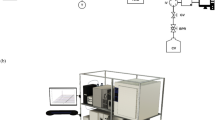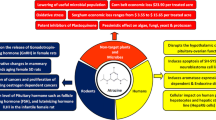Abstract
Dithiocarbamates constitute an important class of broad-spectrum antifungal compounds used extensively in agriculture, including in the cultivation of spices. Maximum residue limits for these compounds have been enforced by several importing countries in international food trade. Validation of analytical methods for dithiocarbamates in spices have not been reported previously. A quick and sensitive method for estimation of total dithiocarbamates as carbon disulphide (CS2) using GC-MS in two major spices, viz. small cardamom (Elettaria cardamomom) and black pepper (Piper nigrum) was optimized and validated. Dithiocarbamate residues in these spice matrices were extracted and subjected to acid hydrolysis followed by reduction to CS2, which was then quantitatively absorbed into isooctane and analysed using GC-MS, employing selected ion monitoring and post-run mid-column backflush technique. For fortification levels from 0.1 to 1.0 mg kg− 1, recoveries obtained ranged from 75 to 98% in cardamom and 76–98% in black pepper, with intra-day precision (RSDr) < 12% and inter-day precision (RSDR) < 15% in all cases. Limit of Quantification of 0.05 mg kg− 1 was achieved in both spices. It was found that there was negligible interference in quantitative accuracy due to essential oils present in the two spices studied. Matrix effect was seen to be suppressive in the two spices studied, and sufficiently low to exclude the use of matrix-matched calibration in routine quantitative analysis. The optimized analytical method was found to be suitable for evaluation of compliance of real samples against the Codex maximum residue limits for cardamom and black pepper. Safety evaluation for human consumption, based on the incidence of Dithiocarbamate residues, was performed in real samples of cardamom and black pepper. This method offers the possibility of extending applicability to other spices also.


Similar content being viewed by others
Data availability
Yes.
Abbreviations
- DTC:
-
Dithiocarbamates.
- GC-MS:
-
Gas chromatograph - mass spectrometer.
- MRLs:
-
Maximum residue limits.
- TMDI:
-
Theoretical maximum daily intake.
- MPI:
-
Maximum permissible intake.
- ADI:
-
Acceptable daily intake.
- DG-SANTE:
-
Director general for health and food safety (European Union).
References
Arslan S, Mert ID, Yiğitkaya S, Dagaşan O, Sakallı FN, Oztürk S (2019) The false positive effect of residue of sulphur sources on dithiocarbamate analysis based on CS2 measurement. Food Addit Contaminants: Part A 36:131–140. https://doi.org/10.1080/19440049.2018.1562235
Caldas ED, Conceição MH, Miranda MCC, de Souza LCKR, Lima JF (2001) Determination of dithiocarbamate fungicide residues in food by a spectrophotometric method using a vertical disulfide reaction system. J Agric Food Chem 49:4521–4525. https://doi.org/10.1021/jf010124a
Chawla S, Patel HK, Gor HN, Vaghela KM, Solanki PP, Shah PG (2017) Evaluation of matrix effects in multiresidue analysis of pesticide residues in vegetables and spices by LC-MS/MS. J AOAC Int 100:616–623. https://doi.org/10.5740/jaoacint.17-0048
Chawla S, Patel H, Kalasariya R, Shah P (2019) Validation and analysis of thiram, a dithiocarbamate, as CS2 from soybean (Glycine max) samples on GC–MS. Int J Environ Sci Technol 16:6991–6998. https://doi.org/10.1007/s13762-018-2069-0
Codex MRL, Cardamom (2015) Codex Maximum Residue Limits in HS 0775 - Cardamom. http://www.fao.org/fao-who-codexalimentarius/codex-texts/dbs/pestres/commodities-detail/en/?lang=en&c_id=745. Accessed 11 Feb 2021
Codex MRL, Pepper (2015) Codex Maximum Residue Limits in HS 0790 - Pepper, black, white. http://www.fao.org/fao-who-codexalimentarius/codex-texts/dbs/pestres/commodities-detail/en/?c_id=171. Accessed 11 Feb 2021
Crnogorac G, Schwack W (2009) Residue analysis of dithiocarbamate fungicides. TRAC Trends Anal Chem 28:40–50. https://doi.org/10.1016/j.trac.2008.10.008
Cuadros-Rodríguez L, García-Campaña AM, Almansa-López E, Egea-González FJ, Cano MLC, Frenich FG, Martínez-Vidal JL (2003) Correction function on biased results due to matrix effects: application to the routine analysis of pesticide residues. Anal Chim Acta 478:281–301. https://doi.org/10.1016/S0003-2670(02)01508-8
Dubey JK, Heberer T, Stan H-J (1997) Determination of ethylenethiourea in food commodities by a two-step derivatization method and gas chromatography with electron-capture and nitrogen-phosphorus detection. J Chromatogr A 765:31–38. https://doi.org/10.1016/S0003-2670(02)01508-8021-9673(96)01008-4
Ekroth SB, Ohlin B, Österdahl B-G (1998) Rapid and simple method for determination of thiram in fruits and vegetables with high-performance liquid chromatography with ultraviolet detection. J Agric Food Chem 46:5302–5304. https://doi.org/10.1021/jf980910o
Erney D, Gillespie A, Gilvydis D, Poole C (1993) Explanation of the matrix-induced chromatographic response enhancement of organophosphorus pesticides during open tubular column gas chromatography with splitless or hot on-column injection and flame photometric detection. J Chromatogr A 638:57–63. https://doi.org/10.1016/0021-9673(93)85007-T
EU Community Reference Laboratories for Residues of Pesticides (2009) Analysis of Dithiocarbamate Residues in Foods of Plant Origin involving Cleavage into Carbon Disulfide, Partitioning into Isooctane and Determinative Analysis by GC-ECD, Single Residue Method Version 2. https://www.eurl-pesticides.eu/library/docs/srm/meth_DithiocarbamatesCs2_EurlSrm.PDF. Accessed 20 Jul 2020
EUR-Lex (2021) The European Pesticide Database. https://ec.europa.eu/food/plant/pesticides/eu-pesticides-db_en. Accessed 11 Feb 2021
FAO/WHO (1994) Pesticide Residues in Food-1993 Evaluations. Part 11-Toxicology
Gras R, Luong J, Shellie R (2017) Gas chromatography and diode array detection for the direct measurement of carbon disulfide in challenging matrices. Anal Methods 9:3908–3913. https://doi.org/10.1039/C7AY00392G
European Commission (2020) Guidance document on analytical quality control and method validation procedures for pesticide residue analysis in food and feed (SANTE/12682/2019)
Gustafsson KH, Thompson RA (1981) High-pressure liquid chromatographic determination of fungicidal dithiocarbamates. J Agric Food Chem 29:729–732. https://doi.org/10.1021/jf00106a012
Horwitz W, Albert R (2006) The Horwitz ratio (HorRat): a useful index of method performance with respect to precision. J AOAC Int 89:1095–1109. https://doi.org/10.1093/jaoac/89.4.1095
Kakitani A, Yoshioka T, Nagatomi Y, Harayama K (2017) A rapid and sensitive analysis of dithiocarbamate fungicides using modified QuEChERS method and liquid chromatography–tandem mass spectrometry. J pesticide Sci D 17–025. https://doi.org/10.1584/jpestics.D17-025
Kesari R, Gupta V (1998) A sensitive spectrophotometric method for the determination of dithiocarbamate fungicide and its application in environmental samples. Talanta 45:1097–1102. https://doi.org/10.1016/S0039-9140(97)00208-7
Latimer GW (2016) AOAC Official methods of analysis of AOAC International, 20th edn
Lehotay SJ, Kwon H, Lucía G-A, Sample Preparation and Matrix Effects in the Detection of Chemical Residues in Foods. http://www.laprw2011.fq.edu.uy/pdf/Lunes/Steven%20Lehotay.pdf. Accessed 25 Dec 2020
Liu S, Bai A, Zhou L, Yu c, Li Y, Fan S, Pa C (2015) Dissipation and residues of thiram in potato and soil. J Chem. https://doi.org/10.1155/2015/623847. 1–6:2015
Mujawar S, Utture SC, Fonseca E, Matarrita J, Banerjee K (2014) Validation of a GC–MS method for the estimation of dithiocarbamate fungicide residues and safety evaluation of mancozeb in fruits and vegetables. Food Chem 150:175–181. https://doi.org/10.1016/j.foodchem.2013.10.148
Oellig C, Schwack W (2017) Comparison of HILIC columns for residue analysis of dithiocarbamate fungicides. J Liq Chromatogr Relat Technol 40:415–418. https://doi.org/10.1080/10826076.2017.1315724
Rahman MM, El-Aty AA, Shim J-H (2013) Matrix enhancement effect: a blessing or a curse for gas chromatography?—a review. Anal Chim Acta 801:14–21. https://doi.org/10.1016/j.aca.2013.09.005
Ravindran P (2000) Black pepper: Piper nigrum. CRC Press
Ravindran P, Madhusoodanan K (2002) Cardamom: the genus Elettaria. Tailor and Francis Group, CRC Press
Schenck FJ, Lehotay SJ (2000) Does further clean-up reduce the matrix enhancement effect in gas chromatographic analysis of pesticide residues in food? J Chromatogr A 868:51–61. https://doi.org/10.1016/S0021-9673(99)01137-1
Schmidt B, Christensen HB, Petersen A, Sloth JJ, Poulsen ME (2013) Method validation and analysis of nine dithiocarbamates in fruits and vegetables by LC-MS/MS. Food Addit Contaminants: Part A 30:1287–1298. https://doi.org/10.1080/19440049.2013.801083
Shabeer TPA, Girame R, Utture S, Oulkar D, Banerjee K, Ajay D, Arimboor R, Menon KRK (2018) Optimization of multi-residue method for targeted screening and quantitation of 243 pesticide residues in cardamom (Elettaria cardamomum) by gas chromatography tandem mass spectrometry (GC-MS/MS) analysis. Chemosphere 193:447–453. https://doi.org/10.1016/j.chemosphere.2017.10.133
Siruguri V, Bhat RV (2015) Assessing intake of spices by pattern of spice use, frequency of consumption and portion size of spices consumed from routinely prepared dishes in southern India. Nutr J 14:7. https://doi.org/10.1186/1475-2891-14-7
Thomas J, Suseela Bhai R (1995) Fungal and bacterial diseases of cardamom. Elettaria cardamomum Maton) and their management
Vettorazzi G, Almeida WF, Burin GJ, Jaeger RB, Puga FR, Rahde AF, Reyes FG, Schvartsman S (1995) International safety assessment of pesticides: dithiocarbamate pesticides, ETU, and PTU—a review and update. Teratog Carcinog Mutagen 15:313–337. https://doi.org/10.1002/tcm.1770150608
Xu G, Nie J, Li H, Yan Z, Cheng Y (2017) Determination of mancozeb residue in fruit by derivatization and a modified QuEChERS method using ultraperformance liquid chromatography–tandem mass spectrometry. Anal Bioanal Chem 409:5057–5063. https://doi.org/10.1007/s00216-017-0451-2
Acknowledgements
The authors gratefully acknowledge the use of instrumentation facilities at Quality Evaluation Laboratory (Kochi, Kerala), Spices Board, Ministry of Commerce, Government of India.
Funding
Not applicable.
Author information
Authors and Affiliations
Contributions
The analytical work was carried out by Ramesh Babu Natarajan, Ranjith Arimboor, Joby Jacob and Binumol Thankan under the guidance of Joby Thomas Kakkasery.
Corresponding author
Ethics declarations
Conflict of interest
The authors declare that there are no conflicts of interests or competing interests.
Additional information
Publisher’s note
Springer Nature remains neutral with regard to jurisdictional claims in published maps and institutional affiliations.
Electronic supplementary material
Below is the link to the electronic supplementary material.
Rights and permissions
About this article
Cite this article
Natarajan, R.B., Kakkasery, J.T., Arimboor, R. et al. Development and validation of a GC-MS method for analysis of Dithiocarbamate Fungicide residues in the Spices Cardamom (Elettaria cardamomom) and black pepper (Piper nigrum). J Food Sci Technol 59, 4097–4107 (2022). https://doi.org/10.1007/s13197-022-05462-9
Revised:
Accepted:
Published:
Issue Date:
DOI: https://doi.org/10.1007/s13197-022-05462-9




